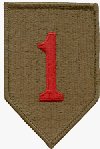U.S. 1st Infantry Division
|
|
The 1st Infantry Division of the United States Army —nicknamed the Big Red One after its shoulder patch—is the oldest continuously serving division in the American Army.
| Contents |
World War I
The First Expeditionary Division, later designated the 1st Infantry Division, was organized in May 1917 under the command of Brigadier General William L. Sibert, from Army units then in service on the Mexican border and at various Army posts throughout the United States.
The first units sailed from New York and Hoboken, N.J., June 14, 1917. Throughout the remainder of the year, the rest of the Division followed, landing at St. Nazaire, France, and Liverpool, England. After a brief stay in rest camps, the troops in England proceeded to France, landing at Le Havre. The last unit arrived in St. Nazaire December 22. Upon arrival in France, the Division, less its artillery, was assembled in the First (Gondrecourt) training area, and the artillery was at Le Valdahon.
On the 4th of July, the 2nd Battalion, 16th Infantry (2-16), paraded through the streets of Paris to bolster the sagging French spirits. At Lafayette's tomb, one of General John J. Pershing's staff uttered the famous words, "Lafayette, we are here!" Two days later, July 6, the First Expeditionary Division was redesignated as the First Infantry Division.
On the morning of October 23, the first American shell of the war was sent screaming toward German lines by a First Division artillery unit. Two days later, the 2-16th Inf., suffered the first American casualties of the war.
By April 1918, the Germans had pushed to within 40 miles of Paris. In reaction to this thrust, the Big Red One moved into the Picardy Sector to bolster the exhausted French First Army. To the Division's front lay the small village of Cantigny, situated on the high ground overlooking a forested countryside. The 28th Inf. Regiment attacked the town, and within 45 minutes captured it along with 250 German soldiers. It was the first American victory of the war. The 28th was thereafter named the "Black Lions of Cantigny".
Soissons was taken by the First Division in July 1918. The Soissons victory was costly—700 men were killed or wounded. The First Infantry helped to clear the St. Mihiel salient by fighting continuously from September 11–13, 1918. The last major World War I battle was fought in the Meuse-Argonne Forest. The Division advanced seven kilometers and defeated, in whole or part, eight German divisions. The war was over when the Armistice was signed. The Division was at Sedan, the farthest American penetration of the war. The Division was the first to cross the Rhine into occupied Germany. By the end of the war, the Division had suffered 22,668 casualties and boasted five Medal of Honor recipients.
World War II
In World War II, the division landed in Oran, Algeria as part of Operation Torch. Elements then took part in seesaw combat at Maktar, Medjez el Bab, Kasserine Pass, Gafsa, El Guettar, Béja, and Mateur, 21 January – 9 May 1943, helping secure Tunisia.
In July, 1943 it took part in Operation Husky in Sicily under the command of Major General Terry de la Mesa Allen. It was assigned to U.S. II Corps. On 7 August 1943, command was assumed by Major General Clarence R. Huebner.
When that campaign was over, the Division returned to England to prepare for the Normandy invasion. It was the division that stormed Omaha Beach on D-Day, some units suffering 30 percent casualties in the first hour, and secured Formigny and Caumont in the beachhead. The Division followed up the St. Lo break-through with an attack on Marigny, 27 July 1944, and then drove across France in a continuous offensive, reaching the German border at Aachen in September. The Division laid siege to Aachen, taking the city after a direct assault, 21 October 1944. The First then attacked east of Aachen through Hurtgen Forest, driving to the Roer, and moved to a rest area 7 December for its first real rest in 6 months' combat, when the von Rundstedt offensive suddenly broke loose, 16 December. The Division raced to the Ardennes, and fighting continuously from 17 December 1944 to 28 January 1945, helped blunt and turn back the German offensive. Thereupon, the Division attacked and again breached the Siegfried Line, fought across the Roer, 23 February 1945, and drove on to the Rhine, crossing at the Remagen bridgehead, 15–16 March 1945. The Division broke out of the bridgehead, took part in the encirclement of the Ruhr Pocket, captured Paderborn, pushed through the Harz Mountains, and was in Czechoslovakia, at Kinsperk, Sangerberg, and Mnichov, when the war in Europe ended.
Vietnam – Present
The division fought in the Vietnam War from 1965 to 1970.
The division also participated in Operation Desert Storm, rolling over the Iraqi 26th Infantry Division and taking 11,400 prisoners in four days.
As of 2004, the division is headquartered at Leighton Barracks in Würzburg, Germany, but has been sent to Iraq, where it relieved as part of Operation Iraqi Freedom (OIF-2) the U.S. 4th Infantry Division in Sunni Area, mainly near towns such as Tikrit, Saddam's hometown, since March 2004. The Division has been replaced by the U.S. 42nd Infantry Division, New York National Guard, and has returned to its home in Germany.
See also
- The Big Red One (1980), a primarily fictional movie about the Division's experiences in WWII.
- Call of Duty 2: Big Red One (2005), video game currently in development that focuses on the Division in WWII.
External links
- 1st Infantry Division website (http://www.1id.army.mil/)
- Commanders of 1st Division (http://www.army.mil/CMH/matrix/1ID/1ID-Cdrs.htm)
- GlobalSecurity.org page on 1ID (http://www.globalsecurity.org/military/agency/army/1id.htm)
- The First! The Story of the 1st Infantry Division (WWII divisional history booklet, 1945) (http://www.lonesentry.com/gi_stories_booklets/1stinfantry/)sl:1. pehotna divizija (ZDA)


